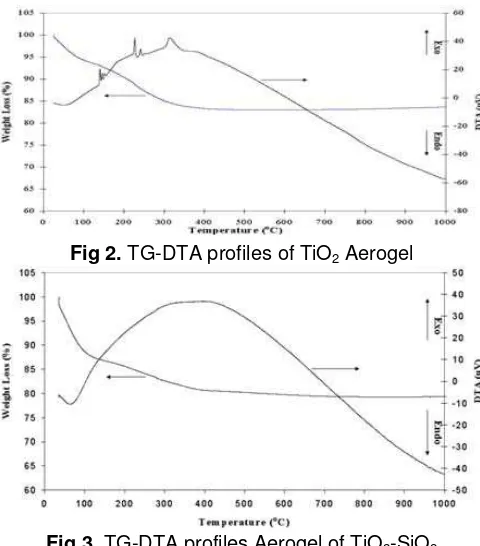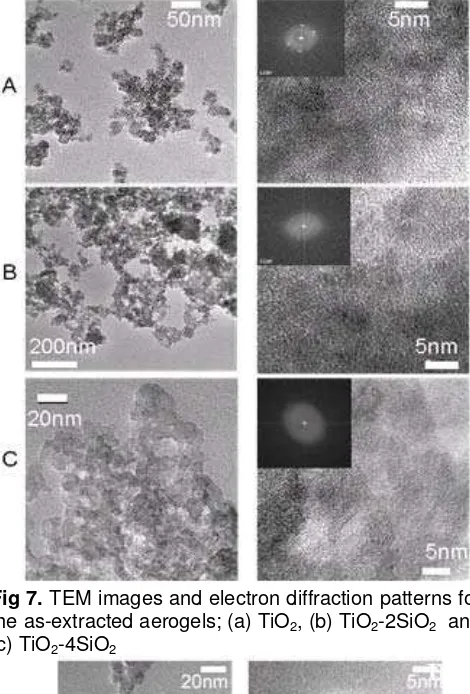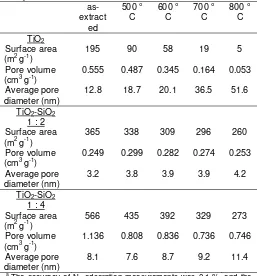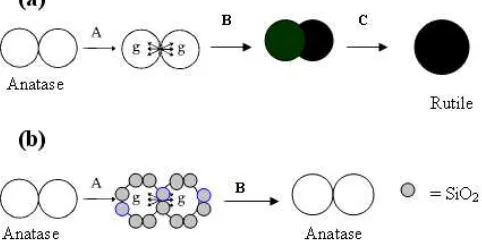PREPARATION OF MESOPOROUS TITANIA-SILICA AEROGELS
BY CO
2SUPERCRITICAL EXTRACTION
Silvester Tursiloadi*, Dinie Mansur, Yeny Meliana and Ruslan Efendi
Research Center for Chemistry, Indonesian Institute of Sciences, Kawasan PUSPIPTEK, Serpong, Tangerang 15314, Indonesia
Received 15 April 2007; Accepted 1 June 2007
ABSTRACT
Stable anatase is attractive because of its notable functions for photocatalysis and photon-electron transfer.
TiO2-nanoparticles dispersed SiO2 wet gels were prepared by hydrolysis of Ti(OC4H9
n
)4 and Si(OC2H5)4 in a
2-propanol solution with acid catalyst. The solvent in the wet gels was supercritically extracted using CO2 at 60 oC and
22 Mpa in one-step. Thermal evolution of the microstructure of the extracted gels (aerogels) was evaluated by XRD
measurements, TEM and N2 adsorption measurements. The as-extracted aerogel with a large specific surface area,
more than 365 m2g-1, contained anatase nanoparticles, about 5 nm in diameter. The anatase phase was stable after
calcinations at temperatures up to 1000 oC, and BET specific surface area, total pore volume and average pore
diameter did not change significantly after calcinations at temperature up to 800 oC.
Keywords: Stable anatase, sol-gel, CO2 supercritical extraction.
INTRODUCTION
Anatase type titania exhibits high photocatalytic activity, and thus has attracted a great deal of attention in the field of photocatalysts for decomposition of environmental pollutants such as organic halides [1] and for antifouling and antibacterial application [2,3]. However, there are significant challenges in obtaining mesoporous titania with full anatase crystalline domains. On the other hand, at standard pressure (1bar) and normal temperatures, rutile is a thermodynamically more stable phase possessing smaller band gap energy (3.0 eV) than the anatase phase (3.2eV), and lower photocatalytic activity [4,5]. Anatase nanocrystals show higher photocatalytic activities than the bulk crystals because the nanocrystals facilitate the diffusion of excited electrons and holes toward the surface before their recombination [6]. In addition, the anatase nanocrystals must be highly dispersed in the host matrix without aggregation to improve the activity. Mesoporous TiO2-SiO2 gel, a combination of highly adsorptive silica
matrix and highly photo-active titania nanoparticles, will be an interesting material for photocatalytic applications. The syntheses of ultrafine titania powders has been investigated using various techniques including hydrothermal treatment, oxidation of titanium powder, and vapor decomposition [7-9]. The sol-gel syntheses are widely used for preparation of transition metal oxides with nanoscale microstructures, and provide excellent chemical homogeneity and the possibility of deriving unique metastable phases at low reaction temperatures. The high porosity and the high specific surface area of material prepared by the sol-gel method make them very attractive from catalytic point of view. However, the titania powders prepared by the sol-gel method are usually amorphous, and the crystallization temperature
is relatively high. The crystallization temperature can be reduced with the hydrothermal treatment, and depends on the temperature of hydrothermal treatment [10,11]. The heat treatment is a significant step with respect to device fabrication. Excessive heating causes mesopore collapse, leading to the formation of dense materials, due to excessive crystal growth and sintering, which in turn will decrease device efficiency [12,13]. Additionally, the localized crystal domain limits the photoactivity of the resultant materials [14-16]. Recently, the preparation of mesoporous titania which has highly porous and a fully crystalline phase domain has been scarcely explored [17,18]. Supercritical extraction techniques are recently used in material science to fabricate highly porous materials [19]. The supercritical extraction technique seems to be a good alternative to overcome the problems of low porosity and low specific surface area of sol-gel derived titania.
In this work, a new route to prepare mesoporous titania with highly porous and full anatase domains of TiO2-nanoparticles dispersed SiO2 aerogels were
prepared by the sol-gel method and supercritical extraction, and the stability of anatase phase and the porous structure, i.e. pore size and specific surface area, has been discussed.
EXPERIMENTAL SECTION
TiO2-SiO2 wet gels were prepared by hydrolysis of
titanium tetra-n-butoxide Ti(OC4H9)4 (TNB) and
tetraethylortosilicate Si(OC2H5)4 (TEOS) in a
2-propanol solution with acid catalyst. The molar ratios used for the synthesis were [TNB+TEOS]: [H2O]:
solvent = 1: 13.4: 127 and [HNO3]: [TNB+TEOS] =
Fig 1. Flowchart of sample preparation
1:4 in mol. The TEOS was firstly dissolved in 2-propanol at room temperature, and a mixture of the catalyst solution, remaining 2-propanol, H2O and HNO3 was
added, and then stirred for 30 min. After that, TNB was added and then the catalyst solution was added under continuous stirring. The solution gelled around 3h after the addition of the catalyst solution. The gel time was defined as the time required after mixing for the vortex created by the stirring to disappear completely. The wet gel was placed in the flow of supercritical carbon dioxide in a supercritical extraction system at 60 oC and 22 Mpa for 4h. The supercritically extracted aerogels were calcined at 500, 600, 700, 800, 900 and 1000 oC for 2 h in air (Fig 1).
Changes in the microstructure of the aerogels during heating were evaluated by measurements of N2
adsorption (Quantachrome, Autosorb). The specific surface area and pore volume of aerogels, before and after calcinations, were estimated by the BET and Barret-Joyner-Halenda (BJH) method [20] using N2
desorption curves. The pore and grain sizes of the samples were estimated from the images observed by a transmission electron microscope (TEM, Philips, TECNAI F20). Crystallization behaviors of the samples were detected by an X-ray diffractometer (Rigaku, RAD-C) after calcinations.
RESULT
TG and DTA profiles of TiO2 and TiO2-2SiO2
aerogels are showed in Fig 2 and Fig 3. For the TiO2
aerogel, weight loss around 5 % was mainly observed at around 80 oC (Fig 2). Beyond 400 oC the sample of TiO2
aerogel practically lose no more weight. In the DTA curve, the TiO2 aerogel showed endothermic peak
Fig 2. TG-DTA profiles of TiO2 Aerogel
Fig 3. TG-DTA profiles Aerogel of TiO2-SiO2
around 80 oC and weak triplet exothermic peaks around 150and 250 oC which accompanied weight loss around 8% and 5% respectively. The broad exothermic peak at around 310 oC is followed by weight loss around 4% also observed. For the TiO2-2SiO2 aerogel (Fig 3),
weight loss around 13 % was mainly observed at around 100 oC.
Beyond 400 oC, the sample of TiO2-2SiO2 aerogel
loses practically no more weight. In the DTA curve, the TiO2-2SiO2 aerogel showed endothermic peak around
100 oC accompanied weight loss around 13% and around 400 oC weight loss around 5% and no exothermic peak. Endothermic peaks appeared in almost the same temperature region for both samples namely at around 100 oC as the evaporation of water and 2-propanol as hydrolyzing reagent and solvent, respectively.
The X-ray powder diffraction peaks of anatase were found for the as-extracted TiO2 aerogel (Fig 4).
The anatase phase was stable after calcination at 500
o
C. After calcination at 600 oC, weak peaks of rutile were found along with the anatase peaks. After calcination at 700 oC, the diffraction peaks of anatase disappeared and only the peaks of rutile were found. The X-ray diffraction peaks of anatase were found for the as-prepared TiO2-2SiO2 aerogel, too (Fig 5). The
anatase phase in the TiO2-2SiO2 aerogel was stable
after calcinations at temperatures up to 1000 oC, and no peaks of rutile were observed (Fig 5). The as-extracted gel of TiO2-4SiO2 was amorphous by XRD
Fig 4. XRD patterns of the TiO2 aerogels as-prepared
and after calcination at various temperatures
Fig 5. XRD patterns of the TiO2-2SiO2 aerogels
as-prepared and after calcination at various temperatures
Fig 6. XRD patterns of the TiO2-4SiO2 aerogels after
calcination at various temperatures
anatase can be found, and hardly changed by calcinations at higher temperatures up to 900oC (Fig 6).
Fig 7 shows the TEM images and electron diffraction patterns for the as-prepared aerogels of TiO2
and TiO2-SiO2. The crystalline structures were assigned
to anatase from the electron diffraction patterns for TiO2
and TiO2-2SiO2 aerogels. Many small anatase particles
were observed throughout the as-prepared TiO2 and
Fig 7. TEM images and electron diffraction patterns for
the as-extracted aerogels; (a) TiO2, (b) TiO2-2SiO2 and
(c) TiO2-4SiO2
Fig 8. TEM images for the aerogels after calcination at
500oC; (a) TiO2 and (b) TiO2-2SiO2
TiO2-2SiO2 aerogels (Fig 7 (a) and (b)). The particle
size of anatase in the as-prepared TiO2- and the TiO2
-2SiO2 aerogels was about 5 nm in diameter. The TEM
images and electron diffraction pattern (Fig. 8(a)) show that the anatase particle size in the TiO2 aerogel
increased about to 13 nm after calcination at 500 oC, and the anatase particle size in the TiO2-2SiO2 aerogel
Fig 9. TEM images for the aerogels after calcination at 700oC; (a) TiO2 and (b) TiO2-2SiO2
Fig 10. TEM images and electron diffraction patterns for
TiO2-4SiO2 calcined (a) at 700 o
C and (b) at 800oC
for the TiO2-2SiO2 aerogel, but not for the TiO2 aerogel.
After calcination at 700 oC, the particle size of the TiO2
aerogel increased significantly, about 90 nm in diameter, but the anatase particle size of the TiO2-2SiO2 aerogel
did not changed significantly i.e. 10 nm (Figs. 9(a) and (b)). Amorphous particles were still found for the TiO2
-2SiO2 aerogel in addition to the anatase particles.
Crystalline nanoparticles were hardly found for the TiO2-4SiO2 aerogels after calcinations at temperatures
up to 700 oC. However, anatase nanoparticles, about 5nm in diameter, were found for the TiO2-4SiO2 aerogel
after calcination at 800 oC (Fig 10(b)).
Table 1 shows the effect of calcination temperatures on the total pore volume, the specific surface area and the average pore diameter of the aerogels. The total pore volume of the as-prepared TiO2
was 0.56 cm3g-1, and after calcinations at 600 oC, it became 0.35 cm3g-1 and was larger than the total pore volume of the TiO2-2SiO2 aerogel, 0.25 and 0.28 cm
3
g-1, respectively. After calcinations at temperatures higher
Table 1. Specific surface area, cumulative pore
volume, and average pore diameter of the TiO2 and
TiO2-SiO2 aerogels after calcination at various
temperatures. a
0.555 0.487 0.345 0.164 0.053
Average pore
0.249 0.299 0.282 0.274 0.253
Average pore
1.136 0.808 0.836 0.736 0.746
Average pore diameter (nm)
8.1 7.6 8.7 9.2 11.4
a
The accuracy of N2 adsorption measurements was 0.1 %, and the
reproducibility of these values for each sample was within 10 %.
than 600 oC, the total pore volume of the TiO2 aerogel
decreased remarkably and became smaller than that of the TiO2-2SiO2 aerogel. However, the pore volume for
the TiO2-2SiO2 aerogels after calcinations at
temperatures up to 800 oC hardly changed. The specific surface area of the as-extracted TiO2 aerogel,
195 m2g-1, was smaller than that of the as-extracted TiO2-2SiO2 aerogel, 365 m
2
g-1, and it drastically decreased after calcination at 500 oC, 90 m2g-1. On the contrary, changes in the specific surface area of the TiO2-2SiO2 aerogel by calcinations were not significant.
After calcinations at 800 oC, the specific surface area of the TiO2-2SiO2 aerogel was still large, 260 m
2
g-1. Also, the changes in the average pore diameter of the TiO2
-2SiO2 aerogel by calcinations, from 3.2 nm
as-extracted to 4.2 nm after calcinations at 800 oC, were not significant in comparison with the changes of the TiO2 aerogel, from 12.8 nm as-extracted to 51.6 nm
after calcinations at 800 oC. These results show that the porous structure of the TiO2-2SiO2 aerogel was
thermally stable at temperatures up to 800 oC in comparison with the TiO2 aerogel. The as-extracted
TiO2-4SiO2 aerogels had larger specific surface area,
DISCUSSION
Exothermic peaks are hardly found for the TiO2
-2SiO2 aerogel. It may be caused by the solvent (alcohol)
that hardly remained in the TiO2-2SiO2 aerogel. The
solvent of the TiO2-2SiO2 may be removed by the
supercritical extraction. The temperature needed to eliminate residual alcoxy group of TiO2 aerogel were
found up to 400 oC that is indicated that a lot of residual alcoxy group still remain.
By the supercritical CO2-extraction in one-step,
highly porous TiO2-SiO2 gels with a large specific
surface area have been obtained. Aerogels are usually prepared by the two-step drying process, i.e. substitution of solvent in wet gels with liquid CO2 and then
supercritical extraction. The substitution of solvent usually needs a long time and complex operations, and therefore, the one-step extraction method will be the better alternative. The effect of CO2 supercritical
extraction on the crystallization can be seen in Fig 4 and Fig 5. Under the high pressure during the CO2
supercritical extraction (22 Mpa), crystalline anatase nanoparticles were formed for both of the TiO2 and the
TiO2-2SiO2 aerogel. The as-prepared TiO2-4SiO2
aerogel is amorphous by XRD (Fig 6), probably due to the low concentration of crystalline phase. After calcinations at 800 oC, the electron diffraction pattern for small particles in the TiO2-4SiO2 aerogel shows the
anatase structure. Anatase phase cannot be found if drying is performed under an ambient pressure. In general, the structure of anatase is formed at temperatures higher than 400 oC [10,21]. However, it was reported previously that anatase phase can be found for TiO2 gel film after hydrothermal treatment at
temperatures in the range between 80 oC and 180 oC [21]. Water vapor was considered to enhance the crystallization of TiO2 gel through cleavage of Ti-O-Ti
bond by hydrolysis [21]. Under high pressure during the supercritical extraction, residual H2O may enhance the
deposition of anatase. On the other hand, solubility of substances into supercritical fluids is usually high, and it can be considered that anatase nanoparticles are formed in supercritical CO2 by the solution-deposition
mechanism from amorphous TiO2. However, the
solubility of TiO2 in supercritical CO2 is not known, and
the further discussion should be needed.
The relationship with anatase nucleation and role of SiO2 were show in Fig 11(a) and (b). The anatase
nanoparticles in the TiO2 aerogel, about 5nm in diameter
(Fig 7(a)), grow up to ca. 13 nm after calcinations at 500
o
C (Fig 8(a)), the diffraction peaks of rutile are found at 600 oC (Fig 4), and the particles of rutile grow up to ca. 90 nm after calcinations at 700 oC (Fig 9(a), Fig 11(a)). On the contrary, grain growth of anatase nanoparticles in the TiO2-2SiO2 aerogels was hardly observed at
temperatures up to 700 oC (Fig 8(b) and Fig 9(b)). The
grain growth is restricted with addition of SiO2 (Fig
11(b)). Anatase nanoparticles in the TiO2-2SiO2
aerogel are surrounded with SiO2 nanoparticles and
highly dispersed, thus the grain growth rate is low (Fig 11(b)). Also, a large amount of SiO2 will retard the
crystallization of TiO2 and the phase transition from
anatase to rutile, probably due to the small particle size of anatase (Fig 14(b)). After calcinations at 600 oC, diffraction peaks of rutile were found for the TiO2
aerogel, but not for the TiO2-2SiO2 aerogels. The shift
of crystallization- and phase transition temperatures of small particles and thin films from those of bulk materials, usually higher temperatures, is often reported.
Crystallization or phase transformations take place through nucleation and growth processes. The Gibb’s free energy is difference between the amorphous and crystalline phases or between two crystalline phases [22,23]. In the phase transformation of nanocrystalline anatase particles of TiO2 shows in
Fig 11(a). Interface nucleation step A, nucleation of
rutile starts within the interface between two contacting anatase particles, and the nucleation rate is determined by the probability of contact of two anatase particles [24]. Nuclei growth step B, as for any nucleation event, the formation of a stable nucleus is dependent upon interfacial energy. Fluctuation of a rutile nucleus within an anatase particle of around critical size for rutile would almost certainly result in rapid transformation of the entire particle (Fig. 11(a)), removing the interfacial energy contribution. The particle size in diameter of anatase phase of TiO2 did not change after calcination
up to 600 oC, namely 13 nm (step A and B). Thus, the critical nucleus size of TiO2 is 13 nm (Table 1 and Fig
8(a)). Formation of a rutile particle steps C, involves growth at the particle-particle neck from constituents evidently provided by surface diffusion. The growth of rutile may happen when a rutile crystallite comes into contact with an anatase crystallite forming a larger rutile crystallite or when two rutile nuclei merge together.
Figure 11. Diagram showing steps involved in the phase
transformation of nanocrystalline anatase particles TiO2 (a)
In the phase transformation of nanocrystalline anatase particles of TiO2-2SiO2 shows in Fig 11(b).
Interface nucleation step A, nucleation of rutile starts within the interface between two contacting anatase particles, and the nucleation rate is determined by the probability of contact of two anatase particles. Nuclei growth step B, is restricted with addition of SiO2 and
critical size for rutile did not achieve. Anatase nanoparticles in the TiO2-2SiO2 aerogel are surrounded
with SiO2 nanoparticles and highly dispersed, thus the
nuclei growth rate is low. Also, a large amount of SiO2
will retard the nuclei growth of TiO2 and the phase
transition from anatase to rutile, probably due to the small particle size of anatase i.e. 10 nm (Fig 9).
The above calcination experiments TiO2-2SiO2
indicate that no anatase transform to rutile. Author consider this to be a consequence of the dependence of thermodynamic stability on particle size, noting that TiO2-2SiO2 and TiO2 growth rates differ, causing
changes in relative stability during thermal treatments. Fig 8 and 9 illustrate the nanocrystalline anatase particles (nm) after calcination at 500 and 700 oC. It is seen that, at particle size of anatase c.a. 13 nm and c.a.10 nm for TiO2 and TiO2-2SiO2 respectively, anatase
is the most stable phase; for particles sizes greater than 13 nm for TiO2, rutile is the most stable phase. For TiO2
-2SiO2, the particle size is stable in small size namely
c.a.10 nm after calcination at 700 oC or more, anatase is the most stable. The thermodynamic of the size effect on the thermal stability of TiO2 anatase nanoparticles
synthesized by MOCVD was reported by Li et al.[25]. 12nm anatase had the lowest transformation starting temperature and thermal stability as compared with 17 and 23 nm samples [25]. Anatase is most thermodynamically stable at sizes less than 11nm, brookite is most stable at sizes between 11 and 35 nm, and rutile is most stable at size greater than 35 nm [26].
The specific surface areas of the aerogels after calcinations at various temperatures are shown in Table 1. With increasing calcination temperatures, the specific surface areas of the TiO2 aerogel decrease drastically,
but did not change significantly for TiO2-SiO2 aerogels.
This is due to the restriction of the grain growth with addition of SiO2.
CONCLUSION
The technique of CO2 supercritical extraction
makes it possible to produce highly porous anatase with small particle size. With addition of a large amount of SiO2, the grain growth rate of crystalline TiO2, anatase,
is restricted, and anatase phase is thermally stabilized. The rutile phase was not found after calcinations at temperatures up to 1000 oC. The transformation sequence among the anatase and rutile is size dependent, because the energies of the anatase and rutile are sufficiently close that they can be reversed by
small differences in surface energy. If particle sizes of the TiO2-2SiO2 and TiO2 phases are equal or smaller
than 13nm anatase is most thermodynamically stable. The rutile is most stable at sizes greater than 13 nm. The specific surface area, the pore volume and the average pore size of TiO2-SiO2 aerogels do not change
significantly after calcinations at temperatures up to 800 oC.
REFFERENCES
1. Weaver, S. and Mills, G., 1997, J. Phys. Chem. B, 101, 3769
2. Matsubara, H., Tanaka, M., Koyama, S., Hashimoto, K., and Fujishima, A., 1995, Chem.
Lett., 1995, 767.
3. Ohko, Y., Tryk, D.A., Hashimoto, K., and Fujishima, A., 1998, J Phys. Chem. B, 102 , 2699
4. Sclafani, A., and Herrman, J.M., 1996, J. Mater. Res., 100, 13655
5. Kormann, C., Bahnemann D.W., and Hoffmann, M.R., 1988, J. Phys. Chem., 92, 5196
9. Mazdiyasni, K.S., Lynch C.T., and Smith, J.S., 1965, J. Am. Ceram. Soc., 48, 372
10. Wang, C.C., and Ying, J.Y., 1999, Chem. Mater., 11, 3113
11. Ovenstone, J., and Yanagizawa, K., 1999, Chem.
Mater., 11, 2770
12. Wang, T.Y.Q., Yin, L.X., Palchik, O., Hacohen, Y.R., Koltypin, Y., and Gedanken, A., 2001,
Langmuir, 17, 4131.
13. Mason (Ed.). 1990, Sonochemistry: The Uses of
Ultrasound in Chemistry, Royal Society of
Chemistry, Cambridge.
14. Fujishima, A., and Honda, K., 1972, Nature 238, 37 15. Phillips, R., 1983, Sources and Applications of
Ultraviolet Radiation, p. 124, Academic Press, New
York.
16. Gedanken, A., Tang, X., Wang, Y., Perkas, N., Koltypin, Y., Landau, M.V., Vradman, L., and Herskowitz. M., 2001, Chem. Eur. J., 7, 4546. 17. Srivastava, D.N., Perkas, N., Gedanken, A., and
Felner. I., 2002, J. Phys. Chem. B 106, 1878. 18. Srivastava, D.N., Chappel, S., Palchik, O., Zaban,
A., and Gedanken, A., 2002, Langmuir 18, 4160. 19. Suh, D.J., Park, T.J., Kim, J.H., and Kim, K.L.,
1997, Chem. Mater., 9, 9, 1903
20. Barret, E.P., Joyner L.G., and Halenda, P.H., 1951,
21. Imai, H., Morimoto, H., Tominaga, A., and Hirashima, H., 1997, J. Sol-gel Sci.and Tech., 10, 45
22. Kasuga, T., Hiramatsu, M., Hoson, A., Sekino, T., and Niihara, K., 1999, Adv. Mater. 11, 1307.
23. Kumar, K-N.P., Keizer, K., Burggraaf, A.J., Okubo, T. and Nagamoto, H., 1993, J. Mater. Chem. 3, 1151.
24. Zhang, H. and Banfield, D.F., 1999, Am.
Mineralogist, 84, 528
25. Li, W., Ni, C., Lin, H., Huang, C.P. and Ismat S., 2004, J. Applied Physics, 96, 11, 663.



